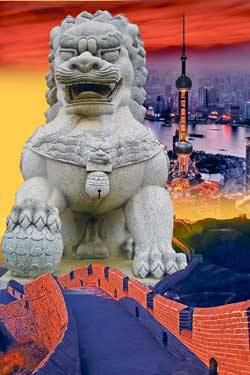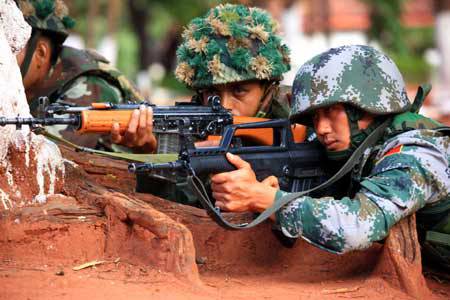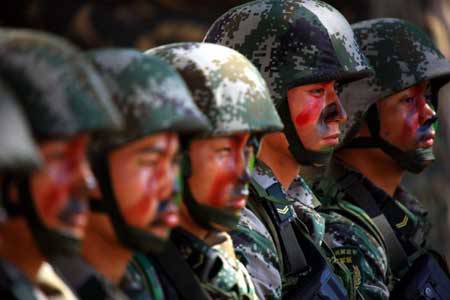The geography of Chinese power
 China is very well located on the world map. Because of this, he has the opportunity to widely spread his influence on land and at sea: from Central Asia to the South China Sea, from the Russian Far East to the Indian Ocean.
China is very well located on the world map. Because of this, he has the opportunity to widely spread his influence on land and at sea: from Central Asia to the South China Sea, from the Russian Far East to the Indian Ocean.At the end of his article “Geographical axis stories”Published in 1904 year and having gained worldwide fame, Sir Halford Mackinder expressed particular concern regarding China. Explaining why Eurasia is the geostrategic power center of the world, Mackinder suggested that the Chinese, if they can extend influence far beyond their own country, “can turn into a yellow peril to world freedom. And just for the reason that they will connect the long ocean border with the resources of the vast continent - the trump card that Russia had been deprived of, which had been in charge of this axial region before. ”
Taking out the racist sentiment that is usual for the beginning of the 20th century, as well as the hysterical reaction that a powerful external force always causes in the West, we can say that Mackinder was not in vain worried. If such a Eurasian giant, as Russia, was and still remains mainly a land power, whose ocean border is blocked by Arctic ice, then China combines the signs of a land power and a sea one. Its coastline stretches for nine thousand miles, replete with comfortable natural harbors and lies in a temperate zone. (Mackinder even warned that China would ever conquer Russia.) The potential influence of the Middle Kingdom extends from Central Asia with its richest reserves of minerals and hydrocarbons to the main sea routes crossing the Pacific Ocean. Later in the book Democratic Ideals and Reality, Mackinder predicted that eventually China would rule the world along with the United States and Great Britain, “having built a new civilization for a quarter of humanity, not quite eastern and not completely western.”

DOMESTIC DEVELOPMENT FEEDS FOREIGN POLICY AMBITIONS
The favorable geographical position of China is so obvious that it is not always remembered about it, speaking of the rapid economic progress of this country and the assertive national character of the Chinese. And yet this should not be forgotten, because sooner or later geography will provide China with a key role in geopolitics, no matter how winding its path to the status of a world power. (Over the past 30 years, the country's annual GDP growth exceeded 10%, but in the next three decades one can hardly expect the same rates.) China combines elements of an extremely modernized Western-style economy with a “hydraulic civilization” inherited from the Ancient East (the term historian Karl Wittfogel, used for societies that practice centralized control over soil irrigation).
Thanks to management from a single center, the Chinese regime is able, for example, to recruit millions of labor armies for the construction of major infrastructure facilities. This also informs the country of steady progressive development - such rates simply cannot be expected from democratic states, which are used to slowly harmonizing the interests of their citizens. Chinese leaders are formally considered communists. But in terms of borrowing Western technologies and practices, they are the successors of some of the 25 imperial dynasties that ruled the country for four thousand years and built the Western experience into a tough and developed cultural system that has, among other things, unique experience of imposing vassal relations other states. “The Chinese,” a Singaporean official told me at the beginning of this year, “are able to pursue their own carrot and whip, systematically alternating both methods.”
Troubles are brewing on the horizon ("The Sydney Morning Herald", Australia)
Domestic development of the Celestial Empire feeds its foreign policy ambitions. Empire rarely built on the finished project, their growth occurs organically. Growing stronger, the state cultivates new needs and, paradoxically, new fears that encourage it to expand in one way or another. So, even under the guidance of the most colorless presidents of the end of the XIX century - Rutherford Hayes, James Garfield, Chester Arthur, Benjamin Harrison, the economy of the United States was steadily and evenly developing. As the country increased its trade with the outside world, it had diverse economic and strategic interests in the most remote parts of the world. Sometimes, as in South America and the Pacific, for example, military intervention was justified by these interests. At that time, the American administration could also concentrate on foreign policy, because the situation was strong inside the country - the last major battle of the Indian wars dates back to 1890.
Today, China is strengthening its land borders and directing its activity outside. This country's ambitious ambitions are as aggressive as the United States a century earlier, but for completely different reasons. Beijing does not practice a missionary approach to foreign policy, does not seek to establish its own ideology or system of government in other countries. Moral progress in international politics is a goal pursued by America; this prospect does not attract Chinese. The behavior of the Middle Kingdom in relation to other countries is entirely dictated by its need for the supply of energy, metals and strategic raw materials necessary to maintain the ever-growing standard of living of a gigantic population, which is about one-fifth of the world's population.
To solve this problem, China has built profitable commodity relations with both neighboring and distant countries, with all those who have the resources it needs to fuel growth. In its foreign policy, the PRC cannot but proceed from a fundamental national interest — economic survival, and therefore we have the right to characterize this country as a super-realistic, super-pragmatic power. Hence the desire to strengthen the presence in various parts of Africa, where there are large reserves of oil and minerals, to secure transport routes in the Indian Ocean and the South China Sea, connecting the coast of the country with the Arab-Persian world, which is so rich in hydrocarbons. Essentially deprived of choice in its actions in the international arena, Beijing does not particularly care about which regimes it has to deal with: partners need stability, not integrity, as the West understands it. And since some of these regimes, say, Iran, Myanmar (also known as Burma) and Sudan, are immersed in the darkness of backwardness and authoritarianism, the tireless search for suppliers of raw materials, which China leads around the world, gives rise to conflicts between it and the United States. orientation. There are tensions with countries such as India and Russia, into whose spheres of influence Beijing is trying to penetrate.
Of course, it does not threaten the existence of these states. The probability of a war between China and the United States is insignificant, the Chinese army represents only an indirect danger to the United States. We are talking here mainly about the challenge of a geographical nature - in spite of fundamental differences on issues of external debt, the structure of trade or global warming. The zone of Chinese influence that is being formed in Eurasia and Africa is constantly growing, and not in the superficial, purely quantitative sense that was given to this concept in the 19th century, but in a deeper, corresponding to the era of globalization. Pursuing a simple goal - to reliably satisfy its economic needs, China shifts the political equilibrium towards the Eastern Hemisphere, and this cannot but affect the interests of the Americans in the most serious way. Taking advantage of its convenient position on the world map, the Celestial Empire extends and expands its influence everywhere and everywhere - from Central Asia to the South China Sea, from the Russian Far East to the Indian Ocean. This country is becoming a powerful continental power, and the policies of such states, according to the famous dictum of Napoleon, cannot be separated from their geography.

BORDER BORDER SYNDROME
Xinjiang and Tibet are the two most significant regions within the PRC, whose inhabitants were able to preserve their originality, having resisted the dominant position of Chinese civilization. In a certain sense, it is the distinctive character of both areas that makes the country look like an empire. In addition, ethnic tensions in both regions complicate Beijing’s relations with the adjacent states.
"Xinjiang" means "new ownership", the so-called Chinese Turkestan, the most western province of the state, twice as big as Texas and separated from the central regions of the country by the Gobi Desert. Although the statehood of the Celestial Empire in one form or another has millennia, Xinjiang officially became its part only at the end of the XIX century. Since then, the history of this province, as the English diplomat Sir Fitzroy Macklin remarked in the last century, “was exceptionally restless,” Xinjiang rebelled every now and then and at times achieved complete independence from Beijing. This continued until 1949, when Mao Zedong’s communist forces invaded Xinjiang and annexed the province by force. Nevertheless, relatively recently, in 1990 and in the past, 2009, its Turkic population - the Uighurs, descendants of the Turkic tribes that ruled Mongolia in the VII-VIII centuries - rebelled against the Peking regime.
Pentagon: China continues to increase military capabilities
Uigurs in China, there are only about eight million - less than one percent of the total population, but in Xinjiang their 45%, almost half. The main ethnic group of the People's Republic of China, the Han people, inhabits the fertile low-lying regions in the center of the country and on the coast of the Pacific Ocean, while the arid plateaus in the west and south-west are historical sites of the Uygur and Tibetan minorities. Such a distribution of the population remains a source of constant tension, since Beijing believes that the modern Chinese state should exercise strict and undivided control in the mountainous regions. In an effort to firmly bind both regions together with the reserves of oil, natural gas, copper and iron ore, which are located in their depths, Beijing for several decades purposefully resettled the Han Chinese from the central regions. In addition, he diligently flirted with the independent Turkic republics in Central Asia, partly in order to deprive the rebellious Xinjiang Uighurs of any potential rear.
By establishing ties with the governments of the Central Asian republics, the Chinese leadership pursued another goal — to expand its zone of influence. China has penetrated deep into Eurasia right now, but this is still not enough to meet its need for natural resources. The influence of Beijing in Central Asia is symbolized by two large pipelines, whose construction is nearing completion: one runs through Kazakhstan and is intended to supply Xinjiang with oil produced in the Caspian Sea, and the other passing through Kazakhstan and Uzbekistan, Xinjiang will receive natural gas from Turkmenistan Moreover, the acute need for natural resources makes Beijing embark on rather risky enterprises. In war-torn Afghanistan, he has been developing a copper deposit south of Kabul, and has long been eyeing reserves of iron, gold, uranium and precious stones (one of the last untouched deposits in the world). Beijing expects to build roads and pipelines in Afghanistan and Pakistan that will link the promising Central Asian region, where it claims its dominance, with port cities on the shores of the Indian Ocean. So strategically, China’s geographical position will only improve if the United States manages to stabilize the situation in Afghanistan.
Tibet, like Xinjiang, plays a fundamental role for the Chinese national identity and, like Xinjiang, complicates China’s relations with other states. The rocky Tibetan Plateau, rich in iron and copper ore, occupies a colossal space. That is why Beijing is becoming increasingly worried about the possibility of autonomy for Tibet, not to mention its complete independence, and with such diligence is building highways and railways connecting this region with other parts of the country. If Tibet were separated, only a short curvature would remain from China, and India in this case would sharply increase in the subcontinent due to the annexation of the northern zone (these are disputed areas in China’s Kashmir, as well as the Indian state of Arunachal Pradesh, which by area make up almost 150 thousand sq. km. - Ed.).
India, with its population of more than one billion people, is already cutting a zone of Chinese influence in Asia with a blunt wedge. This is especially clearly seen on the map of “Greater China”, which is placed in Zbigniew Brzezinski’s book, The Big Chessboard (1997). To a certain extent, the geographical position of China and India really dooms them to rivalry: neighboring countries with a huge population, rich and ancient cultures have long been claiming the same territories (for example, the Indian state of Arunachal Pradesh). The problem of Tibet only complicates the situation. India granted asylum to the government of the Dalai Lama, who has been in exile since 1957. Daniel Twining, a senior fellow at the German Marshall Foundation, said the recent incidents on the Sino-Indian border "may be explained by China’s concern about the successor to the Dalai Lama." After all, it is likely that the next Dalai Lama will come from the Tibetan cultural belt, including North India, Nepal and Bhutan, and therefore more prone to pro-Indian and, accordingly, anti-Chinese orientation.
China and India will have to play each other “on a large scale” not only in these regions, but also in Bangladesh and Sri Lanka. Xinjiang and Tibet, as before, remain inside the officially recognized borders of China, but taking into account the strained relations between the Chinese government and residents of both provinces, we can expect that in future Beijing’s attempts to extend its influence beyond the Han ethnic majority will meet with serious opposition.

People’s Liberation Army of China (PLA)
CREATIVE IMPACT
Even on those parts of the border where nothing threatens China, the country's form itself looks frighteningly unfinished, as if parts of the once-existing Great China were seized in these places. China's northern border covers Mongolia, a vast territory that looks like a tuft torn from its back. The population density of Mongolia is among the lowest in the world and the proximity of urban Chinese civilization poses an undoubted demographic threat to it. Having once conquered Outer Mongolia, in order to gain access to more suitable agricultural land, China is now ready to conquer it again, but in a modern way - putting into service reserves of oil, coal, uranium, as well as luxurious empty pastures. Since uncontrolled industrialization and urbanization have turned China into the world's largest consumer of aluminum, copper, lead, nickel, zinc, tin, and iron ore (its share in global metal consumption has jumped from 10 to 25% over the last decade), Chinese mining companies have frankly made bet on the development of rich mineral resources of the neighboring country. The relationship with Mongolia once again shows how widely Beijing’s imperialist designs extend, especially if we recall that China has previously placed Tibet, Macao and Hong Kong under control.
To the north of Mongolia and the three northeastern Chinese provinces lies the Russian Far East - the largest depressive region, twice the size of Europe, with a very small and constantly decreasing population. The Russian state finally incorporated these territories into its structure in the XIX - early XX century, when China was extremely weak. He is now strong, and the power of the Russian government is nowhere as weak as in this eastern third of Russia. At the same time, very close to the seven million Russian population of the Far East (by 2015, its number could be reduced to 4,5 million), about 100 million people live in the three provinces of China. By density, they are superior to the Russian Far East 62 times. Chinese migrants are leaking into Russia, flooding Chita north of the Mongolian border, as well as other cities in the region. Access to resources remains the main goal of China’s foreign policy in any region of the world, and the sparsely populated Russian Far East, which has vast reserves of natural gas, oil, timber, diamonds and gold, is no exception. “Moscow is suspicious of the floods of numerous Chinese settlers that have flowed into the region, followed by timber and mining companies,” wrote David Blair, a London-based Daily Telegraph, last summer.
As in the case of Mongolia, no one fears that the Chinese army will ever conquer or formally annex the Russian Far East. Fear inspires something else: Beijing’s increasingly creeping demographic and economic influence in this region (of which China briefly mastered during the Qing dynasty era). During the Cold War, border disputes between the Celestial Empire and the Soviet Union led to the fact that powerful military units numbering hundreds of thousands of people were deployed in the adjacent areas of Siberia, and at times tensions at the border resulted in direct clashes. At the end of 60, periodic tensions led to a break in relations between the PRC and the USSR. The geographic factor is still quite capable of causing a quarrel between China and Russia, since their current alliance is purely tactical in nature. This can be beneficial to the United States. In 70, President Nixon’s administration benefited from the clash between Beijing and Moscow and marked the beginning of a new relationship with China. In the future, when the latter will become a truly great power, the United States, apparently, could conclude a strategic alliance with Russia in order to balance the influence of the Middle Kingdom.
To be continued
This article was originally published in the journal Russia in Global Affairs (No. 4, July-August 2010)
Information